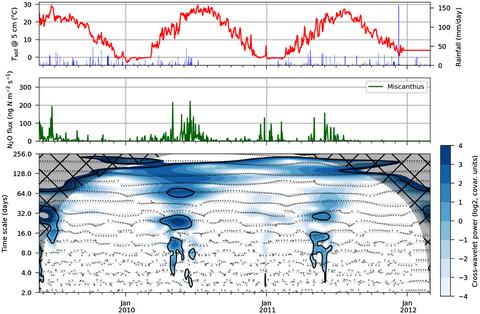当前位置:
X-MOL 学术
›
GCB Bioenergy
›
论文详情
Our official English website, www.x-mol.net, welcomes your
feedback! (Note: you will need to create a separate account there.)
Nitrous oxide fluxes over establishing biofuel crops: Characterization of temporal variability using the cross‐wavelet analysis
Global Change Biology Bioenergy ( IF 5.9 ) Pub Date : 2020-07-27 , DOI: 10.1111/gcbb.12728 Marcelo Zeri 1 , Wendy H. Yang 2, 3, 4 , Gisleine Cunha‐Zeri 5 , Christy D. Gibson 2, 3 , Carl J. Bernacchi 2, 3, 6
Global Change Biology Bioenergy ( IF 5.9 ) Pub Date : 2020-07-27 , DOI: 10.1111/gcbb.12728 Marcelo Zeri 1 , Wendy H. Yang 2, 3, 4 , Gisleine Cunha‐Zeri 5 , Christy D. Gibson 2, 3 , Carl J. Bernacchi 2, 3, 6
Affiliation

|
Emissions of nitrous oxide (N2O) over croplands are a major source of greenhouse gases to the atmosphere. The precise accounting of sources of N2O is essential to national and global budgets, as well as the understanding of the spatial and temporal relationships with environmental variables such as rainfall, air and soil temperature, and soil moisture. The objective of this work was to investigate the temporal correlations of N2O fluxes with soil and air temperatures, as well as soil moisture. N2O fluxes were measured over four biofuel crops in Central Illinois during their establishment phase. Measurements were carried out from 2009 to 2011 using a trace gas analyzer (TGA) with tunable laser technology. Measurements of concentrations of N2O and CO2 were taken at the center of four plots of maize/soybean rotation, miscanthus (Miscanthus × giganteus), switchgrass (Panicum virgatum) and a mixture of native prairie plants. Cumulative fluxes indicate an average emission of nitrogen via N2O fluxes on the order of 1.5 kg N ha−1 year−1, in agreement with chamber measurements previously reported for the site. N2O fluxes were associated with peaks in soil and air temperature, and soil moisture, particularly during spring and winter thaws. Cross‐wavelet analysis was used to investigate the correlation between N2O fluxes and those variables. Results indicate that N2O fluxes and meteorological variables have significant covariance in time scales ranging from 4 to 32 days. In addition, temporal delays of 1–8 days were found in those relationships. Cross‐wavelet patterns were similar when relating N2O fluxes with soil temperature, air temperature and soil moisture. The temporal patterns of fluxes and environmental variables reported here support the modeling of emissions and highlight the importance of considering the timing of fluxes in relation to trends in meteorological variables.
中文翻译:

建立生物燃料作物时的一氧化二氮通量:使用交叉小波分析的时间变化特征
农田上的一氧化二氮(N 2 O)排放是向大气排放温室气体的主要来源。N 2 O来源的精确核算对于国家和全球预算以及了解与环境变量(如降雨,空气和土壤温度以及土壤湿度)的时空关系至关重要。这项工作的目的是研究N 2 O通量与土壤和空气温度以及土壤湿度的时间相关性。N 2在伊利诺伊州中部的四种生物燃料作物建立阶段对它们的O通量进行了测量。从2009年至2011年使用具有可调激光技术的痕量气体分析仪(TGA)进行了测量。N 4 O和CO 2的浓度测量是在四个玉米/大豆轮作区,桔梗(Miscanthus×giganteus),柳枝((Panicum virgatum)和本地草原植物的四个样地的中心进行的。累积通量表示通过N 2 O通量平均排放的氮为1.5 kg N ha -1 year -1,与先前报告的该地点的测量室一致。N 2O通量与土壤,气温,土壤湿度的峰值有关,尤其是在春季和冬季解冻期间。交叉小波分析用于研究N 2 O通量与这些变量之间的相关性。结果表明,N 2 O通量和气象变量在4到32天的时间尺度上具有显着的协方差。此外,在这些关系中发现了1-8天的时间延迟。关联N 2时,交叉小波模式相似O随土壤温度,空气温度和土壤湿度变化。此处报告的通量和环境变量的时间模式支持排放的建模,并强调考虑通量与气象变量趋势相关的时间的重要性。
更新日期:2020-07-27
中文翻译:

建立生物燃料作物时的一氧化二氮通量:使用交叉小波分析的时间变化特征
农田上的一氧化二氮(N 2 O)排放是向大气排放温室气体的主要来源。N 2 O来源的精确核算对于国家和全球预算以及了解与环境变量(如降雨,空气和土壤温度以及土壤湿度)的时空关系至关重要。这项工作的目的是研究N 2 O通量与土壤和空气温度以及土壤湿度的时间相关性。N 2在伊利诺伊州中部的四种生物燃料作物建立阶段对它们的O通量进行了测量。从2009年至2011年使用具有可调激光技术的痕量气体分析仪(TGA)进行了测量。N 4 O和CO 2的浓度测量是在四个玉米/大豆轮作区,桔梗(Miscanthus×giganteus),柳枝((Panicum virgatum)和本地草原植物的四个样地的中心进行的。累积通量表示通过N 2 O通量平均排放的氮为1.5 kg N ha -1 year -1,与先前报告的该地点的测量室一致。N 2O通量与土壤,气温,土壤湿度的峰值有关,尤其是在春季和冬季解冻期间。交叉小波分析用于研究N 2 O通量与这些变量之间的相关性。结果表明,N 2 O通量和气象变量在4到32天的时间尺度上具有显着的协方差。此外,在这些关系中发现了1-8天的时间延迟。关联N 2时,交叉小波模式相似O随土壤温度,空气温度和土壤湿度变化。此处报告的通量和环境变量的时间模式支持排放的建模,并强调考虑通量与气象变量趋势相关的时间的重要性。











































 京公网安备 11010802027423号
京公网安备 11010802027423号